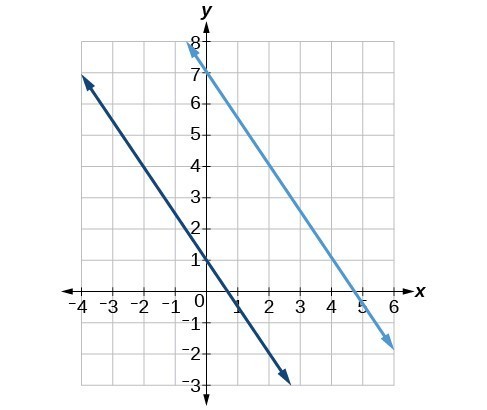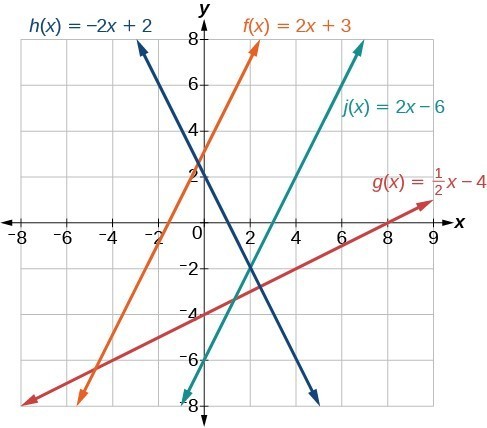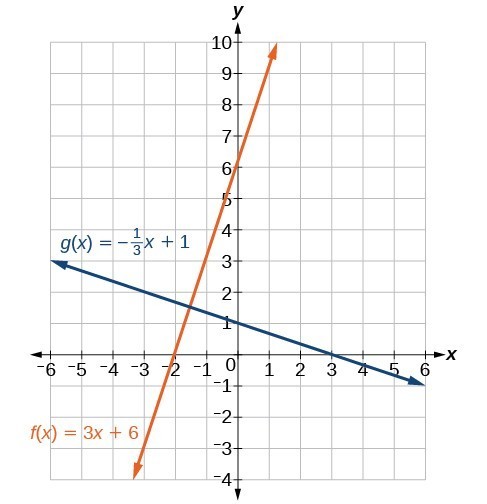Parallel and Perpendicular Lines
Learning Objectives
- Determine whether lines are parallel or perpendicular given their equations
- Find equations of lines that are parallel or perpendicular to a given line
 Parallel lines.
Parallel lines. We can determine from their equations whether two lines are parallel by comparing their slopes. If the slopes are the same and the y-intercepts are different, the lines are parallel. If the slopes are different, the lines are not parallel.
Unlike parallel lines, perpendicular lines do intersect. Their intersection forms a right, or 90-degree, angle. The two lines below are perpendicular.
We can determine from their equations whether two lines are parallel by comparing their slopes. If the slopes are the same and the y-intercepts are different, the lines are parallel. If the slopes are different, the lines are not parallel.
Unlike parallel lines, perpendicular lines do intersect. Their intersection forms a right, or 90-degree, angle. The two lines below are perpendicular.
 Perpendicular lines.
Perpendicular lines.[latex]{m}_{1}{m}_{2}=-1[/latex]
To find the reciprocal of a number, divide 1 by the number. So the reciprocal of 8 is [latex]\frac{1}{8}[/latex], and the reciprocal of [latex]\frac{1}{8}[/latex] is 8. To find the negative reciprocal, first find the reciprocal and then change the sign. As with parallel lines, we can determine whether two lines are perpendicular by comparing their slopes, assuming that the lines are neither horizontal nor perpendicular. The slope of each line below is the negative reciprocal of the other so the lines are perpendicular.[latex]\begin{array}{l}f\left(x\right)=\frac{1}{4}x+2\hfill & \text{negative reciprocal of}\frac{1}{4}\text{ is }-4\hfill \\ f\left(x\right)=-4x+3\hfill & \text{negative reciprocal of}-4\text{ is }\frac{1}{4}\hfill \end{array}[/latex]
The product of the slopes is –1.[latex]-4\left(\frac{1}{4}\right)=-1[/latex]
A General Note: Parallel and Perpendicular Lines
Two lines are parallel lines if they do not intersect. The slopes of the lines are the same.[latex]f\left(x\right)={m}_{1}x+{b}_{1}\text{ and }g\left(x\right)={m}_{2}x+{b}_{2}\text{ are parallel if }{m}_{1}={m}_{2}[/latex].
If and only if [latex]{b}_{1}={b}_{2}[/latex] and [latex]{m}_{1}={m}_{2}[/latex], we say the lines coincide. Coincident lines are the same line. Two lines are perpendicular lines if they intersect at right angles.[latex]f\left(x\right)={m}_{1}x+{b}_{1}\text{ and }g\left(x\right)={m}_{2}x+{b}_{2}\text{ are perpendicular if }{m}_{1}{m}_{2}=-1,\text{ and so }{m}_{2}=-\frac{1}{{m}_{1}}[/latex].
Example: Identifying Parallel and Perpendicular Lines
Given the functions below, identify the functions whose graphs are a pair of parallel lines and a pair of perpendicular lines.[latex]\begin{array}{l}f\left(x\right)=2x+3\hfill & \hfill & h\left(x\right)=-2x+2\hfill \\ g\left(x\right)=\frac{1}{2}x - 4\hfill & \hfill & j\left(x\right)=2x - 6\hfill \end{array}[/latex]
Answer: Parallel lines have the same slope. Because the functions [latex]f\left(x\right)=2x+3[/latex] and [latex]j\left(x\right)=2x - 6[/latex] each have a slope of 2, they represent parallel lines. Perpendicular lines have negative reciprocal slopes. Because −2 and [latex]\frac{1}{2}[/latex] are negative reciprocals, the equations, [latex]g\left(x\right)=\frac{1}{2}x - 4[/latex] and [latex]h\left(x\right)=-2x+2[/latex] represent perpendicular lines.
Analysis of the Solution
A graph of the lines is shown below. The graph shows that the lines [latex]f\left(x\right)=2x+3[/latex] and [latex]j\left(x\right)=2x - 6[/latex] are parallel, and the lines [latex]g\left(x\right)=\frac{1}{2}x - 4[/latex] and [latex]h\left(x\right)=-2x+2[/latex] are perpendicular.
The graph shows that the lines [latex]f\left(x\right)=2x+3[/latex] and [latex]j\left(x\right)=2x - 6[/latex] are parallel, and the lines [latex]g\left(x\right)=\frac{1}{2}x - 4[/latex] and [latex]h\left(x\right)=-2x+2[/latex] are perpendicular.Writing Equations of Parallel Lines
Suppose for example, we are given the following equation.[latex]f\left(x\right)=3x+1[/latex]
We know that the slope of the line formed by the function is 3. We also know that the y-intercept is (0, 1). Any other line with a slope of 3 will be parallel to f(x). So the lines formed by all of the following functions will be parallel to f(x).[latex]\begin{array}{l}g\left(x\right)=3x+6\hfill \\ h\left(x\right)=3x+1\hfill \\ p\left(x\right)=3x+\frac{2}{3}\hfill \end{array}[/latex]
Suppose then we want to write the equation of a line that is parallel to f and passes through the point (1, 7). We already know that the slope is 3. We just need to determine which value for b will give the correct line. We can begin with the point-slope form of an equation for a line, and then rewrite it in the slope-intercept form.[latex]\begin{array}{l}y-{y}_{1}=m\left(x-{x}_{1}\right)\hfill \\ y - 7=3\left(x - 1\right)\hfill \\ y - 7=3x - 3\hfill \\ \text{ }y=3x+4\hfill \end{array}[/latex]
So [latex]g\left(x\right)=3x+4[/latex] is parallel to [latex]f\left(x\right)=3x+1[/latex] and passes through the point (1, 7).How To: Given the equation of a function and a point through which its graph passes, write the equation of a line parallel to the given line that passes through the given point.
- Find the slope of the function.
- Substitute the given values into either the general point-slope equation or the slope-intercept equation for a line.
- Simplify.
Example: Finding a Line Parallel to a Given Line
Find a line parallel to the graph of [latex]f\left(x\right)=3x+6[/latex] that passes through the point (3, 0).Answer: The slope of the given line is 3. If we choose the slope-intercept form, we can substitute [latex]m=3[/latex], [latex]x=3[/latex], and [latex]f(x)=0[/latex] into the slope-intercept form to find the y-intercept.
[latex]\begin{array}{l}g\left(x\right)=3x+b\hfill \\ \text{ }0=3\left(3\right)+b\hfill \\ \text{ }b=-9\hfill \end{array}[/latex]
The line parallel to f(x) that passes through (3, 0) is [latex]g\left(x\right)=3x - 9[/latex].Analysis of the Solution
We can confirm that the two lines are parallel by graphing them. The figure below shows that the two lines will never intersect.
Writing Equations of Perpendicular Lines
We can use a very similar process to write the equation for a line perpendicular to a given line. Instead of using the same slope, however, we use the negative reciprocal of the given slope. Suppose we are given the following function:[latex]f\left(x\right)=2x+4[/latex]
The slope of the line is 2, and its negative reciprocal is [latex]-\frac{1}{2}[/latex]. Any function with a slope of [latex]-\frac{1}{2}[/latex] will be perpendicular to f(x). So the lines formed by all of the following functions will be perpendicular to f(x).[latex]\begin{array}{l}g\left(x\right)=-\frac{1}{2}x+4\hfill \\ h\left(x\right)=-\frac{1}{2}x+2\hfill \\ p\left(x\right)=-\frac{1}{2}x-\frac{1}{2}\hfill \end{array}[/latex]
As before, we can narrow down our choices for a particular perpendicular line if we know that it passes through a given point. Suppose then we want to write the equation of a line that is perpendicular to f(x) and passes through the point (4, 0). We already know that the slope is [latex]-\frac{1}{2}[/latex]. Now we can use the point to find the y-intercept by substituting the given values into the slope-intercept form of a line and solving for b.[latex]\begin{array}{l}g\left(x\right)=mx+b\hfill \\ 0=-\frac{1}{2}\left(4\right)+b\hfill \\ 0=-2+b\hfill \\ 2=b\hfill \\ b=2\hfill \end{array}[/latex]
The equation for the function with a slope of [latex]-\frac{1}{2}[/latex] and a y-intercept of 2 is[latex]g\left(x\right)=-\frac{1}{2}x+2[/latex].
So [latex]g\left(x\right)=-\frac{1}{2}x+2[/latex] is perpendicular to [latex]f\left(x\right)=2x+4[/latex] and passes through the point (4, 0). Be aware that a graphing utility may distort a graph enough that it is hard to tell whether two lines are perpendicular or parallel to each other.Q & A
A horizontal line has a slope of zero and a vertical line has an undefined slope. These two lines are perpendicular, but the product of their slopes is not –1. Doesn’t this fact contradict the definition of perpendicular lines? No. For two perpendicular linear functions, the product of their slopes is –1. However, a vertical line is not a function so the definition is not contradicted.How To: Given the equation of a function and a point through which its graph passes, write the equation of a line perpendicular to the given line.
- Find the slope of the function.
- Determine the negative reciprocal of the slope.
- Substitute the new slope and the values for x and y from the coordinate pair provided into [latex]g\left(x\right)=mx+b[/latex].
- Solve for b.
- Write the equation for the line.
Example: Finding the Equation of a Perpendicular Line
Find the equation of a line perpendicular to [latex]f\left(x\right)=3x+3[/latex] that passes through the point (3, 0).Answer: The original line has slope [latex]m=3[/latex], so the slope of the perpendicular line will be its negative reciprocal, or [latex]-\frac{1}{3}[/latex]. Using this slope and the given point, we can find the equation for the line.
[latex]\begin{array}{l}g\left(x\right)=-\frac{1}{3}x+b\hfill \\ 0=-\frac{1}{3}\left(3\right)+b\hfill \\ \text{ }1=b\hfill \\ b=1\hfill \end{array}[/latex]
The line perpendicular to f(x) that passes through (3, 0) is [latex]g\left(x\right)=-\frac{1}{3}x+1[/latex].Analysis of the Solution
A graph of the two lines is shown below.
Try It
In the graph below, there's a line passing through the points [latex](0,5)[/latex] and [latex](4,1)[/latex]. The line [latex]f(x) = mx+b[/latex] runs parallel to this line.- For what y-intercept will the graph of[latex]f(x)[/latex] pass through the point [latex](-2,5)[/latex]?
- Add a new function that uses the slope m that will create a line that is perpendicular to the function [latex]f(x)=mx-2[/latex].
- For what y-intercept will the new function pass through the point [latex](4,1)[/latex], and still be perpendicular to [latex]f(x)[/latex]
Answer:
- When the y-intercept is [latex](0,3)[/latex] the function will be [latex]f(x) = mx+3[/latex] and the function will pass through the point [latex](-2,5)[/latex].
- [latex]f(x)=\frac{-1}{m}x-2[/latex] for example. Any value for the y-intercept will work.
- The y-intercept [latex](0,-3)[/latex] will give a line perpendicular to [latex]f(x)[/latex] that passes through the point [latex](4,1)[/latex].
How To: Given two points on a line and a third point, write the equation of the perpendicular line that passes through the point.
- Determine the slope of the line passing through the points.
- Find the negative reciprocal of the slope.
- Use the slope-intercept form or point-slope form to write the equation by substituting the known values.
- Simplify.
Example: Finding the Equation of a Line Perpendicular to a Given Line Passing through a Point
A line passes through the points (–2, 6) and (4, 5). Find the equation of a perpendicular line that passes through the point (4, 5).Answer: From the two points of the given line, we can calculate the slope of that line.
[latex]\begin{array}{l}{m}_{1}=\frac{5 - 6}{4-\left(-2\right)}\hfill \\ =\frac{-1}{6}\hfill \\ =-\frac{1}{6}\hfill \end{array}[/latex]
Find the negative reciprocal of the slope.[latex]\begin{array}{l}{m}_{2}=\frac{-1}{-\frac{1}{6}}\hfill \\ =-1\left(-\frac{6}{1}\right)\hfill \\ =6\hfill \end{array}[/latex]
We can then solve for the y-intercept of the line passing through the point (4, 5).[latex]\begin{array}{l}g\left(x\right)=6x+b\hfill \\ 5=6\left(4\right)+b\hfill \\ 5=24+b\hfill \\ -19=b\hfill \\ b=-19\hfill \end{array}[/latex]
The equation for the line that is perpendicular to the line passing through the two given points and also passes through point (4, 5) is[latex]y=6x - 19[/latex]
Try It
A line passes through the points, (–2, –15) and (2, –3). Find the equation of a perpendicular line that passes through the point, (6, 4).Answer: [latex]y=-\frac{1}{3}x+6[/latex]
Licenses & Attributions
CC licensed content, Original
- Revision and Adaptation. Provided by: Lumen Learning License: CC BY: Attribution.
- Parallel and Perpendicular Lines Interactive. Authored by: Lumen Learning. Located at: https://www.desmos.com/calculator/ygbmop3uyv. License: Public Domain: No Known Copyright.
CC licensed content, Shared previously
- College Algebra. Provided by: OpenStax Authored by: Abramson, Jay et al.. Located at: https://openstax.org/books/college-algebra/pages/1-introduction-to-prerequisites. License: CC BY: Attribution. License terms: Download for free at http://cnx.org/contents/[email protected].
